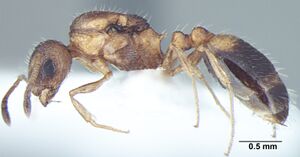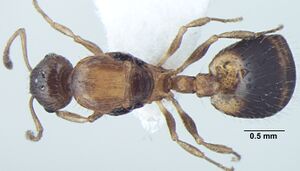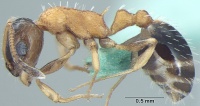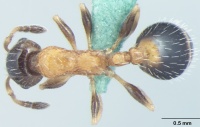Temnothorax kashmirensis
| Temnothorax kashmirensis | |
|---|---|

| |
| Scientific classification | |
| Kingdom: | Animalia |
| Phylum: | Arthropoda |
| Class: | Insecta |
| Order: | Hymenoptera |
| Family: | Formicidae |
| Subfamily: | Myrmicinae |
| Tribe: | Crematogastrini |
| Genus: | Temnothorax |
| Species: | T. kashmirensis |
| Binomial name | |
| Temnothorax kashmirensis Bharti, Gul & Schulz, 2012 | |
The species has been collected from North-West Himalaya, in Kashmir and Himachal Pradesh. The species inhabits moderately wet and lighted coniferous forests with scarce undergrowth and nests mainly under stones.
Identification
Bharti, Gul & Schulz (2012) - Temnothorax kashmirensis is significantly different from all known Himalayan species due to following combination of characters: Head smooth; mesosoma coarsely sculptured; spines long, cylindrical, apices oblique. However, it is somewhat allied to Temnothorax fultonii, which is a bicoloured species, with the head smooth without any distinct sculpture but can be easily differentiated from it by the longer propodeal spines (PSLI = 15–28) and distinct sculpture on mesosoma. In case of Temnothorax fultonii the propodeal spines are much shorter (PSLI = 9–11) and the mesosoma is much smoother.
Keys including this Species
Distribution
Latitudinal Distribution Pattern
Latitudinal Range: 34.187° to 32.231°.
| North Temperate |
North Subtropical |
Tropical | South Subtropical |
South Temperate |
- Source: AntMaps
Distribution based on Regional Taxon Lists
Oriental Region: India (type locality).
Distribution based on AntMaps
Distribution based on AntWeb specimens
Check data from AntWeb
Countries Occupied
| Number of countries occupied by this species based on AntWiki Regional Taxon Lists. In general, fewer countries occupied indicates a narrower range, while more countries indicates a more widespread species. |

|
Estimated Abundance
| Relative abundance based on number of AntMaps records per species (this species within the purple bar). Fewer records (to the left) indicates a less abundant/encountered species while more records (to the right) indicates more abundant/encountered species. |

|
Biology
Castes
Queen
Images from AntWeb
  
| |
| Queen (alate/dealate). Specimen code antweb1008016. Photographer H. Bharti, uploaded by California Academy of Sciences. | Owned by PUN, Punjabi University, Patiala, India. |
Nomenclature
The following information is derived from Barry Bolton's Online Catalogue of the Ants of the World.
- kashmirensis. Temnothorax kashmirensis Bharti, Gul & Schulz, 2012: 329, figs. 4-9 (w.q.) INDIA.
Unless otherwise noted the text for the remainder of this section is reported from the publication that includes the original description.
Description
Worker
TL 2.5–3.3 (3.0); HL 0.63–0.72 (0.70); HW 0.51–0.58 (0.56); SL 0.47–0.56 (0.55); PW 38–43 (0.40); WL 0.67–0.77 (0.77); PL 0.24–0.30 (0.26); PH 0.16–0.20 (0.20); PPL 0.19–0.23 (0.23); GL 0.73–1.24 (1.02); PSL 0.080–0.16 (0.13); FCD 0.18–0.20 (0.20); EL 0.12–0.18 (0.18); PEW 0.14–0.17 (0.17) n = 31.
Head – Longer than broad [CI= 121–125 (122)]; in full face view, posterior margin of head feebly convex; occipital corners less marked than in Temnothorax himachalensis sp. n., moderately round; lateral sides weakly convex; anterior clypeal margin broadly rounded; eyes large, situated about the middle on the sides of the head; mandibles triangular, the masticatory margin with 5 prominent teeth; antennae 12 segmented, scape fairly long, almost reaching posterior margin of head [SI1 = 74–80 (78), SI2 = 92–99 (98)].
Mesosoma, petiole and postpetiole – In profile, mesosoma with weakly convex promesonotal dorsum; metanotal groove shallow, less distinct; humeri in dorsal view rounded; propodeal spines almost cylindrical, apices oblique, long, as long as what approximately is the distance between their bases [PSLI = 15–28 (23)]; petiolar node longer than high with somewhat long anterior peduncle; petiolar node in profile with steep and very slightly concave anterior face and flat to convex dorsum; postpetiolar node as high as petiole with rounded dorsum and wider than petiole.
Gaster – Ovate, smooth and shiny.
Sculpture – Head smooth, except for scattered punctures and longitudinal irregular rugae on genae which run up to the front of eyes and a few rugulae between the frontal carinae; mandibles distinct rugulose; clypeus with a few longitudinal rugae; mesosoma reticulate, rugulose, all over except for the posterodorsal part of pronotum, dorsum of mesonotum and metanotal where the sculpture is indistinct; scattered punctuation all over mesosoma; petiole and postpetiole finely microreticulated and rugulose; petiolar node dorsum circled with distinct carinae (carinae less distinct in some specimens); gaster smooth and shining.
Pilosity – Body covered with suberect to erect blunt hairs, more abundant on gaster; shorter subdecumbent hairs on antennae and legs; decumbent pubescent hairs on antennae and legs, more dense on antennal funiculus.
Colour – The species is bicoloured, with the light to dark brown head and gaster and yellowish to reddish yellow mesosoma, petiole and postpetiole; mandibles, antennae and legs yellowish to brown; pilosity yellowish white.
Queen
TL 3.46; HL 0.70 ; HW 0.66; SL 0.54; PW 0.64; WL 1.12; PL 0.31; PH 0.24; PPL 0.30; GL 1.03; PSL 0.12; PSLI 18; CI 106; SI1 77; SI2 81; FCD 0.21; EL 0.21; PEW 0.22 n = 1.
Resembles the worker, with modifications expected for caste and the following differences: Body massive, more hairy; head longitudinally rugose and reticulated, the rugae covering genae, antennal sockets, whole frontal area except the space in between the frontal carinae and ocelli; clypeus with a few longitudinally rugae placed wide apart; eyes large, three prominent ocelli present; mesosoma weakly longitudinally rugose on dorsum, rugulose on sides with some patches smooth; propodeal spines more or less triangular; petiole, postpetiole with a few rugulae, distinct carinae circling round the petiole dorsum; hairs of varying lengths cover entire body; mesosoma with scutellum at the same level as of the scutum; scutum with a few less distinct rugae, scutellum smooth, propodeal declivity very steep; petiolar node dorsum flat, postpetiole broad; gaster long and thick; colour slightly darker than in workers and irregular.
Type Material
- Holotype, worker, Dara, Kashmir, 2130m, India, 34°11′13″N 74°55′48″E / 34.187°N 74.930°E, 15 December 2011, Punjabi University Patiala Ant Collection.
- Paratype, 15 workers, Dara, Kashmir, 2130m, India, 34°11′13″N 74°55′48″E / 34.187°N 74.930°E, 15 December 2011, CAS, PUPAC, SMNK.
- Paratype, 15 workers, Manali, Himachal Pradesh, 1845m, India, 32°13′52″N 77°11′28″E / 32.2310°N 77.1910°E, 17 June 2010, Irfan Gul, PUPAC; hand collecting.
- Paratype, 6 workers, 1 queen, Kullu Valley, vic. Kalath, 1700–1800m, India, 32°13′52″N 77°11′28″E / 32.2310°N 77.1910°E, 2 October 1996, Andreas Schulz, PCAS, PUPAC.
Etymology
The species is named after the type locality, Kashmir.
References
- Bharti, H., Gul, I., and Schulz, A. 2012. Three new species of genus Temnothorax (Hymenoptera: Formicidae) from Indian Himalayas with a revised key to the Indian species. Acta Zoologica Academiae Scientiarum Hungaricae. 58:325-336.
- Yusupov, Z.M., Dubovikoff, D.A., Lopatina, E.B. 2020. Temnothorax kipyatkovi sp. n. – a new species of ants (Hymenoptera: Formicidae) from India. Caucasian Entomological Bulletin 16, 353–357 (doi:10.23885/181433262020162-353357).
References based on Global Ant Biodiversity Informatics
- Bharti H., I. Gul, A. Schulz. 2012. Three new species of genus Temnothorax (Hymenoptera: Formicidae) from Indian Himalayas with a revised key to the Indian species. Acta Zoologica Academiae Scientiarum Hungaricae 58(4): 325-336.

